LETTERS FROM A LONGARMER : #3 -
In this post, I talk about pantograph quilting, the history of it and the advent of computerisation.
It's confusing...
I know. It's a tad confusing when you hear so many terms for the same thing, but trust me, pantograph, panto, overall, edge-to-edge (often shortened to e2e), all-over, continuous, and even roll-pattern are all used interchangeably to describe one type of quilting. A method whereby one quilting motif (or a series of motifs) is repeated left to right and top to bottom over a quilt.
Having said this, let me rephrase my last paragraph ever so slightly. Although the terms all refer to the same style of quilting, 'pantograph quilting' is a phrase we most associate with longarm quilting. However, the style of quilting - one repeated motif, can be achieved by hand or domestic machine.
Christmas Present...
I came across the word pantograph as a child. One Christmas, I was given a tracing gizmo that I could use to copy, enlarge or reduce a picture from a book. I recall it being awkward to use. It took a while to get the hang of using the stylus in the middle of the gizmo to trace the image and allow the pencil at the end to replicate it. But it did afford me hours of fun.
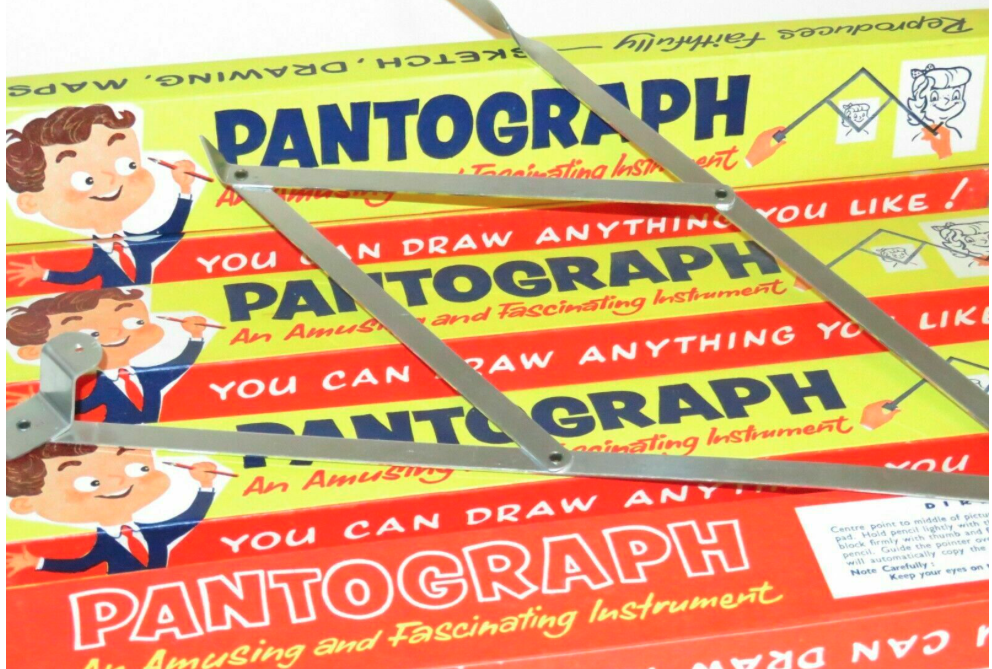
Invented in 1603 by physicist Christopher Scheiner, it was a simple but clever gadget based on the mechanical behaviour of linked rods.

Surprisingly, pantographs are still used today - you can find them on Amazon!
Quilters adopt the concept...
Using the basic concept of the mechanical pantograph, quilters use a stylus (or laser light) connected to the rear of the longarm machine to trace a repeating continuous-line pattern. As they trace, the design is stitched out by the needle at the front of the machine.
The pattern must be at least the width of the quilt to complete the edge-to-edge design. Standard paper pantographs come on rolls of paper 12' long.
Once mastered, the skill of pantograph quilting can be adapted to quilt borders, sashings and blocks.
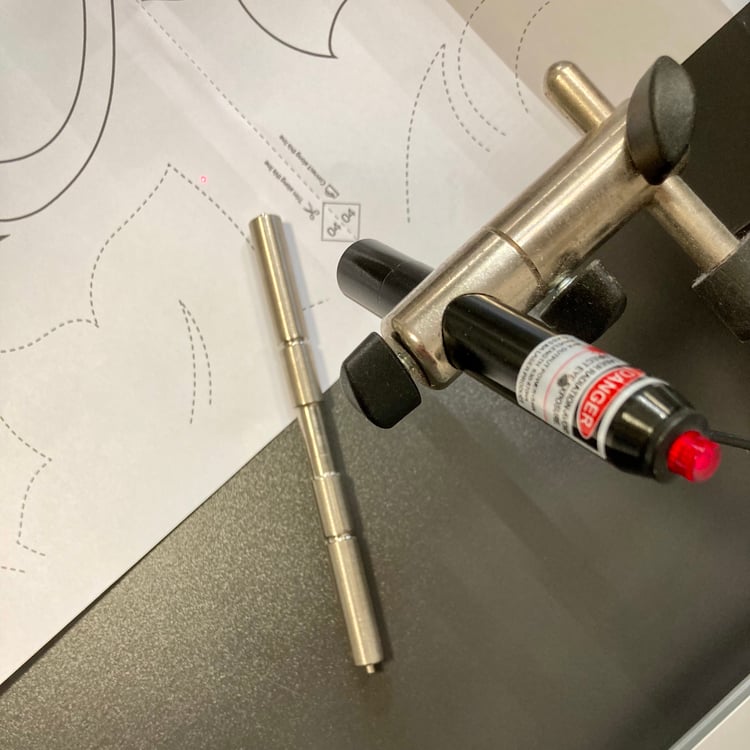
Stylus and laser light used for hand-guided pantograph quilting.
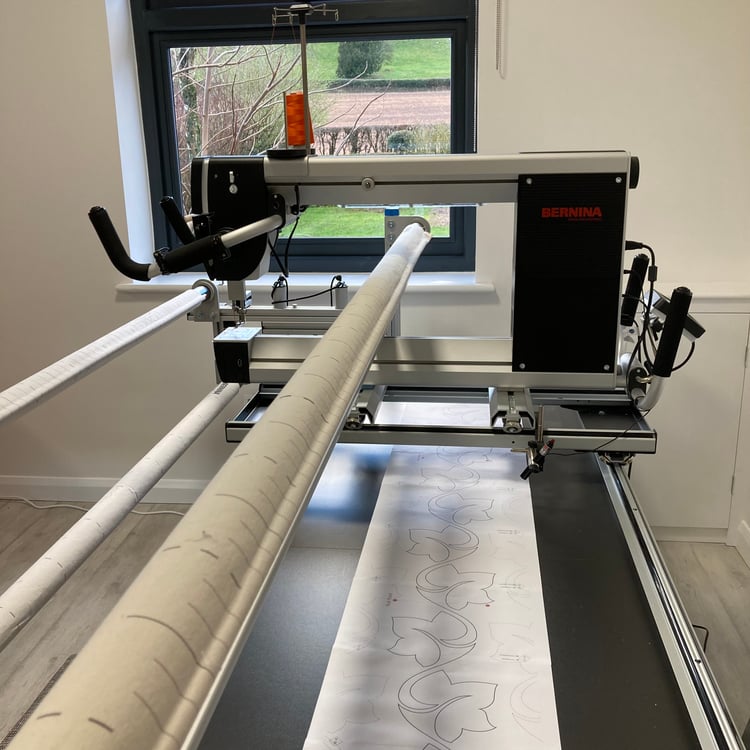
Pantograph roll pattern at the rear of the longarm.

Computerised pantograph...
Computerised pantograph quilting uses a digital form of the pattern and a robotic sewing head to reproduce the design in stitch. So whilst no tracing is required the repeating pattern is still stitched out edge to edge and top to bottom over the quilt.
The digital nature of the pattern allows for quick and easy pattern resizing, alternate row offset and row spacing adjustments.

Straight set pantograph layout

Alternate row offset by 50%
Reasons to panto...
In the Longarm world, pantograph quilting is a quicker and more efficient method of finishing a quilt than custom quilting, where specific designs are placed in particular patches or areas of the quilt top.
Seen somewhat as a poor quilting relation, a carefully chosen pantograph can enhance and add artistry to many types of quilts.
Using a pantograph offers an economical way to finish a quilt in terms of time and budget too.
From my own experience of quilting for hire, I found custom work to take almost 3 times as long as pantograph work, and sometimes with little or no real improvement in the overall appeal of the finished quilt, begging the question, is the extra cost warranted?
Utility, charity, children and pet quilts are usually most suited to pantograph quilting. But where finishing time and budget are considerations for both quilter and maker, pantographs are the ideal choice.
Pantographs also make fabulous modern wholecloths.
Let's also remember that the primary reason for the quilting is to secure the three layers of fabric together. Adding the pretty aesthetic stitches is a bonus and adds further interest to the quilt. With a well-chosen 'panto', it is possible to add function and beauty too.
A little history...
The origins of modern pantograph quilting can be traced back to the mid-20th century when longarm quilting machines were first introduced. The machines, larger and more robust than traditional home sewing machines, offered quilters the ability to manoeuvre and quilt large quilts more efficiently. However, the concept of the first quilting machine was seen much early.
In 1872 Mrs Augusta Hoover received the first US patent for a quilting attachment to a sewing machine. (Patent No.131,443, dated September 17, 1872.) Her invention consisted of two frames that allowed the quilt, attached to one of the frames, to slide along the tracks of the other stationary frame and sew straight lines easily.
Pop over to this fabulous blog post to see Mrs Hoover's invention. Its a worthwhile read if you are interested in history of longarming.
With the current appeal for straight line and match-stick quilting, I suspect a re-invention of Mrs Hoovers' sewing-machine accessory would be much appreciated by today's modern quilters.
The sewing machine gets mobile...
In 1877 J.J Crall patented ..
"an object to manufacture quilts in a rapid and convenient manner by means of a
sewing machine running over fabric stretched in suitable manner".
A forerunner to the modern frame-based quilting system, this is the first time the sewing machine head is placed on tracks, and the fabric is stationary on a frame.
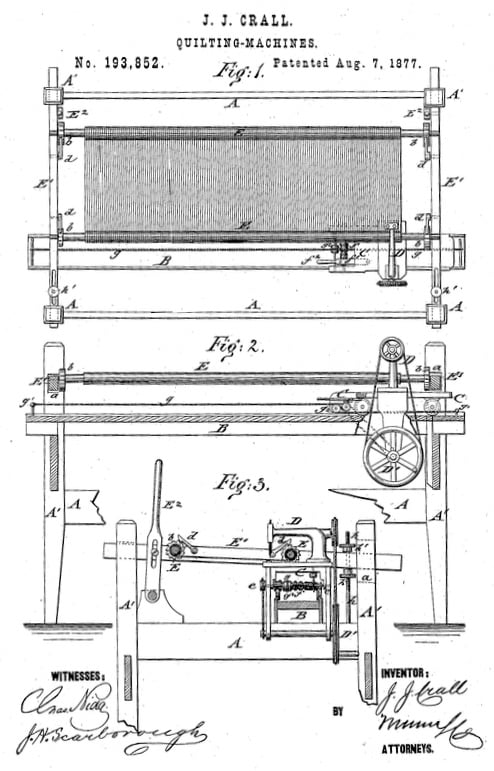
Patent application drawing from JJ Crall.
It would be the late 1950s and early 1960s before we see any further developments leading to the contemporary Longarm quilting machine.
The short-arm...
In the interim, some sewing machine companies spotted a opportunity in the decorator trade. Taking industrial machines off the table and mounting them on tracks proved a boon but it also identified the limitations of the system. The height and depth of the throat space were too short for a rolled comforter or bedspread.
Stretched machines...
Sewing machine companies started experimenting with 'stretched' and 'heightened' machines.
Cutting the sewing machine in half and adding an extended crankshaft produced the stretched long-reach machine, but heightening the throat space was much more complicated.
Longarm development stalled until the late 1970s when two doyens of longarm quilting, Ken Gammill and Fred Nolting, worked together to manufacture the first contemporary longarm quilting machine. The team would later split to form their own longarm companies but not before they had paved the way for the longarm machine and a growing trend for pantograph quilting.
The longarm machine, complete with handles front and back, enabled the concept of hand-guided pantograph quilting to emerge and offer a way to create intricate and consistent patterns across the surface of a quilt. Pantograph quilting gained popularity, and the demand for paper roll patterns increased.
Automation...
By the late 1980s, patents for computerised stitching had already been filed and by 2000 computerised longarm quilting was a reality via Paul Statler and Gammill Quilting. More computer-driven systems followed, and the demand for digital pantographs increased.
Last year I spoke with one longarm brand who told me that 90% of new longarm sales were for computerised machines, but over 50% of the machines in use were still hand-guided.
If correct, the need for both paper and digital pattern design go hand-in-hand.
Either way, pantographs continue to be the bread and butter of the longarm world. Budget, ease of use, design creativity, pattern appeal and availability make pantograph patterns accessible to many quilters.
New panto designs are released weekly by many independent designers. Incredibly, one digital pattern supplier now has a catalogue of over 14,000 designs. Staggering! I've designed around 150 of those for them - a mere drop in the pantograph ocean!
The small issue of choice...
For the future, the problem will be choosing a pattern. Having a choice is good, but too much choice can be overwhelming. I'm waiting for the next significant development - image processing and AI capability to suggest a suitable pattern for me.
This has to be the next development for the world of longarm, don't you think?
Happy Quilting!
Tracey
xx
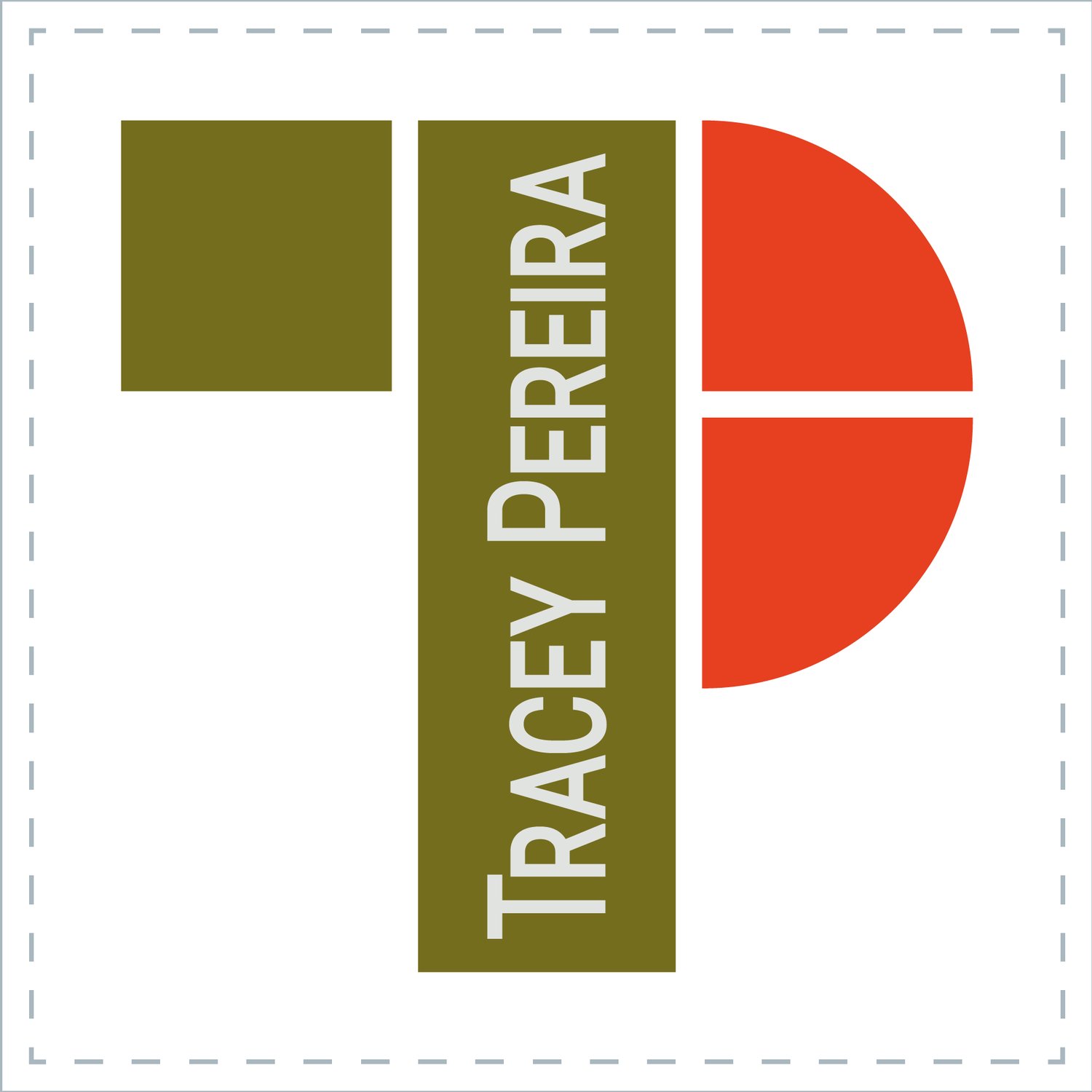


Comments ()